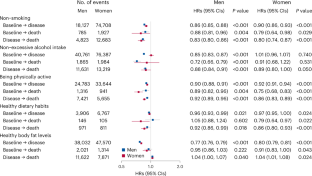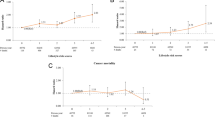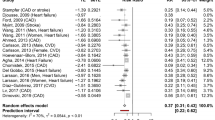Abstract
Whether a healthy lifestyle helps achieve gains in life expectancy (LE) free of major non-communicable diseases and its share of total LE in Chinese adults remains unknown. We considered five low-risk lifestyle factors: never smoking or quitting for reasons other than illness, no excessive alcohol use, being physically active, healthy eating habits and healthy body fat levels. Here we show that after a median follow-up of 11.1 years for 451,233 Chinese adults, the LE free of cardiovascular diseases, cancer and chronic respiratory diseases (95% confidence interval) at age 40 years for individuals with all five low-risk factors was on average 6.3 (5.1–7.5) years (men) and 4.2 (3.6–5.4) years (women) longer than those with 0–1 low-risk factors. Correspondingly, the proportion of disease-free LE to total LE increased from 73.1% to 76.3% for men and from 67.6% to 68.4% for women. Our findings suggest that promoting healthy lifestyles could be associated with gains in disease-free LE in the Chinese population.
This is a preview of subscription content, access via your institution
Access options
Access Nature and 54 other Nature Portfolio journals
Get Nature+, our best-value online-access subscription
$29.99 / 30 days
cancel any time
Subscribe to this journal
Receive 12 digital issues and online access to articles
$119.00 per year
only $9.92 per issue
Buy this article
- Purchase on Springer Link
- Instant access to full article PDF
Prices may be subject to local taxes which are calculated during checkout




Similar content being viewed by others
Data availability
CKB data are available to all bona fide researchers. Details of how to access and details of the data release schedule are available from www.ckbiobank.org/site/Data+Access. As stated in the access policy, the CKB study group must maintain the integrity of the database for future use and regulate data access to comply with prior conditions agreed with the Chinese government. Data security is an integral part of CKB study protocols. Data can be released outside the CKB research group only with appropriate security safeguards.
Code availability
Analysis code for this study is available at https://github.com/qiufen-code/Lifestyle-and-disease-free-LE.
References
GBD 2017 Mortality Collaborators. Global regional, and national age-sex-specific mortality and life expectancy, 1950–2017: a systematic analysis for the Global Burden of Disease Study 2017. Lancet 392, 1684–1735 (2018).
GBD 2017 Disease and Injury Incidence and Prevalence Collaborators. Global regional, and national incidence, prevalence, and years lived with disability for 354 diseases and injuries for 195 countries and territories, 1990-2017: a systematic analysis for the Global Burden of Disease Study 2017. Lancet 392, 1789–1858 (2018).
Fries, J. F. Aging, natural death, and the compression of morbidity. New Engl. J. Med. 303, 130–135 (1980).
From MDGS to SDGS: General Introduction (WHO, 2015).
Pang, Y. J., Yu, C. Q., Guo, Y., Lyu, J. & Li, L. M. Associations of lifestyles with major chronic diseases in Chinese adults: evidence from the China Kadoorie Biobank. Zhonghua Liu Xing Bing Xue Za Zhi 42, 369–75. (2021).
Zhang, Y.-B. et al. Combined lifestyle factors, all-cause mortality and cardiovascular disease: a systematic review and meta-analysis of prospective cohort studies. J. Epidemiol. Community Health 75, 92 (2021).
Zhang, Y. B. et al. Combined lifestyle factors, incident cancer, and cancer mortality: a systematic review and meta-analysis of prospective cohort studies. Br. J. Cancer 122, 1085–1093 (2020).
Li, Y. et al. Healthy lifestyle and life expectancy free of cancer, cardiovascular disease, and type 2 diabetes: prospective cohort study. Br. Med. J. 368, l6669 (2020).
Cuthbertson, C. C. et al. Associations of leisure-time physical activity and television viewing with life expectancy free of nonfatal cardiovascular disease: the ARIC study. J. Am. Heart Assoc. 8, e012657 (2019).
Khan, S. S. et al. Association of body mass index with lifetime risk of cardiovascular disease and compression of morbidity. J. Am. Med. Assoc. Cardiol. 3, 280–287 (2018).
O’Doherty, M. G. et al. Effect of major lifestyle risk factors, independent and jointly, on life expectancy with and without cardiovascular disease: results from the Consortium on Health and Ageing Network of Cohorts in Europe and the United States (CHANCES). Eur. J. Epidemiol. 31, 455–468 (2016).
Dhana, K. et al. Obesity and life expectancy with and without diabetes in adults aged 55 years and older in the Netherlands: a prospective cohort study. PLoS Med. 13, e1002086 (2016).
Nyberg, S. T. et al. Association of healthy lifestyle with years lived without major chronic diseases. J. Am. Med. Assoc. Internal Med. 180, 760–768 (2020).
Stenholm, S. et al. Smoking, physical inactivity and obesity as predictors of healthy and disease-free life expectancy between ages 50 and 75: a multicohort study. Int. J. Epidemiol. 45, 1260–1270 (2016).
Zhou, M. et al. Mortality, morbidity, and risk factors in China and its provinces, 1990–2017: a systematic analysis for the Global Burden of Disease Study 2017. Lancet 394, 1145–1158 (2019).
Qin, F. et al. Exercise and air pollutants exposure: a systematic review and meta-analysis. Life Sci. 218, 153–164 (2019).
Lu, Y. et al. Comparison of prevalence, awareness, treatment, and control of cardiovascular risk factors in China and the United States. J. Am. Heart Assoc. 7, e007462 (2018).
Aggarwal, N. R. et al. Sex differences in ischemic heart disease. Circ. Cardiovasc. Qual. Outcomes 11, e004437 (2018).
Mamun, A. A. et al. Smoking decreases the duration of life lived with and without cardiovascular disease: a life course analysis of the Framingham Heart Study. Eur. Heart J. 25, 409–415 (2004).
Nusselder, W. J., Franco, O. H., Peeters, A. & Mackenbach, J. P. Living healthier for longer: comparative effects of three heart-healthy behaviors on life expectancy with and without cardiovascular disease. BMC Public Health 9, 487 (2009).
Snetselaar, L. G., de Jesus, J. M., DeSilva, D. M. & Stoody, E. E. Dietary guidelines for Americans, 2020–2025: understanding the scientific process, guidelines, and key recommendations. Nutri. Today 56, 287 (2021).
Gong, W. et al. Nutrient supplement use among the Chinese population: a cross-sectional study of the 2010–2012 China nutrition and health surveillance. Nutrients 10, 1733 (2018).
Craig, W. J. Health effects of vegan diets. Am. J. Clin. Nutr. 89, 1627–1633 (2009).
Dale, C. E. et al. Causal associations of adiposity and body fat distribution with coronary heart disease, stroke subtypes, and type 2 diabetes mellitus: a Mendelian randomization analysis. Circulation 135, 2373–2388 (2017).
Zhang, X. et al. Genetically predicted physical activity levels are associated with lower colorectal cancer risk: a Mendelian randomisation study. Br. J. Cancer 124, 1330–1338 (2021).
Larsson, S. C. et al. Smoking, alcohol consumption, and cancer: a Mendelian randomisation study in UK Biobank and international genetic consortia participants. PLoS Med. 17, e1003178 (2020).
Chen, Z. et al. China Kadoorie Biobank of 0.5 million people: survey methods, baseline characteristics and long-term follow-up. Int. J. Epidemiol. 40, 1652–1666 (2011).
Chinese Nutrition Society. The Chinese Dietary Guidelines (People’s Medical Publishing House, 2016).
Zhu, N. et al. Adherence to a healthy lifestyle and all-cause and cause-specific mortality in Chinese adults: a 10-year prospective study of 0.5 million people. Int. J. Behav. Nutr. Phys. Act. 16, 98 (2019).
Xi, B. et al. Relationship of alcohol consumption to all-cause, cardiovascular, and cancer-related mortality in U.S. adults. J. Am. Coll. Cardiol. 70, 913–922 (2017).
Klurfeld, D. M. What is the role of meat in a healthy diet? Anim. Front. 8, 5–10 (2018).
Lee, D. H. et al. Predicted lean body mass, fat mass, and all cause and cause specific mortality in men: prospective US cohort study. Br. Med. J. 362, k2575 (2018).
Han, Y. et al. Lifestyle, cardiometabolic disease, and multimorbidity in a prospective Chinese study. Eur. Heart J. 42, 3374–3384 (2021).
Kurmi, O. P. et al. Validity of COPD diagnoses reported through nationwide health insurance systems in the People’s Republic of China. Int. J. Chron. Obstruct .Pulmon. Dis. 11, 419–430 (2016).
Peeters, A., Mamun, A. A., Willekens, F. & Bonneux, L. A cardiovascular life history. A life course analysis of the original Framingham Heart Study cohort. Eur. Heart J. 23, 458–466 (2002).
Franco, O. H., Peeters, A., Bonneux, L. & de Laet, C. Blood pressure in adulthood and life expectancy with cardiovascular disease in men and women: life course analysis. Hypertension 46, 280–286 (2005).
Tassistro, E., Bernasconi, D. P., Rebora, P., Valsecchi, M. G. & Antolini, L. Modeling the hazard of transition into the absorbing state in the illness–death model. Biom. J. 62, 836–851 (2020).
Tibshirani, R. J. & Efron, B. An introduction to the bootstrap. Monogr Stat. Appl. Prob. 57, 1–436 (1993).
Acknowledgements
The most important acknowledgement is to the participants in the study and the members of the survey teams in each of the ten regional centres, as well as to the project development and management teams based at Beijing, Oxford and the ten regional centres. This work was supported by National Natural Science Foundation of China (82192904 (J.L.), 82192901 (L.L.), 82192900 (L.L.) and 81941018 (J.L.)). The CKB baseline survey and the first resurvey were supported by a grant from the Kadoorie Charitable Foundation in Hong Kong. The long-term follow-up is supported by grants from the UK Wellcome Trust (212946/Z/18/Z, 202922/Z/16/Z, 104085/Z/14/Z and 088158/Z/09/Z) (Z.C.), grants (2016YFC0900500 (Y.G.)) from the National Key R&D Program of China, National Natural Science Foundation of China (81390540 and 91846303) (L.L.) and Chinese Ministry of Science and Technology (2011BAI09B01) (L.L.). The funders had no role in the study design, data collection, data analysis, interpretation, writing of the report or the decision to submit the article for publication.
Author information
Authors and Affiliations
Consortia
Contributions
J.L. and L.L. conceived and designed the study and contributed to the interpretation of the results and critical revision of the paper for valuable intellectual content. L.L., Z.C. and J.C., as the members of the CKB steering committee, designed and supervised the conduct of the whole study, obtained funding and together with C.Y., Y.G., P.P., L.Y., Y.C., H.D., S.B., S.S. and F.N. acquired the CKB data. Q.S. and Y.H. accessed, verified and analysed the data. Q.S. drafted the paper. All authors had access to the data and have read and approved the final paper. The corresponding author attests that all listed authors meet authorship criteria and that no others meeting the criteria have been omitted. J.L. and L.L. are the guarantors.
Corresponding authors
Ethics declarations
Competing interests
The authors declare no competing interests.
Peer review
Peer review information
Nature Human Behaviour thanks Josje Schoufour and the other, anonymous, reviewer(s) for their contribution to the peer review of this work. Peer reviewer reports are available. Primary Handling Editor: Charlotte Payne, in collaboration with the Nature Human Behaviour team.
Additional information
Publisher’s note Springer Nature remains neutral with regard to jurisdictional claims in published maps and institutional affiliations.
Supplementary information
Supplementary Information
Supplementary Text (including a list of CKB members and their affiliations), Methods, Tables 1–4 and Figs. 1–12.
Rights and permissions
Springer Nature or its licensor (e.g. a society or other partner) holds exclusive rights to this article under a publishing agreement with the author(s) or other rightsholder(s); author self-archiving of the accepted manuscript version of this article is solely governed by the terms of such publishing agreement and applicable law.
About this article
Cite this article
The China Kadoorie Biobank Collaborative Group. Healthy lifestyle and life expectancy free of major chronic diseases at age 40 in China. Nat Hum Behav 7, 1542–1550 (2023). https://doi.org/10.1038/s41562-023-01624-7
Received:
Accepted:
Published:
Issue Date:
DOI: https://doi.org/10.1038/s41562-023-01624-7



